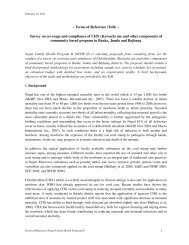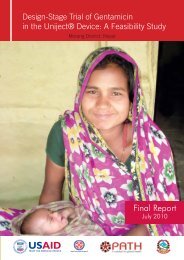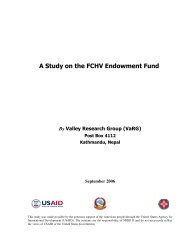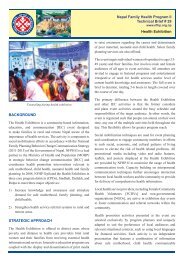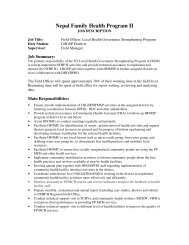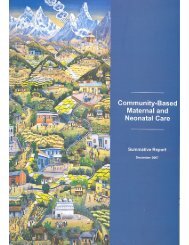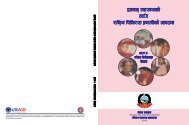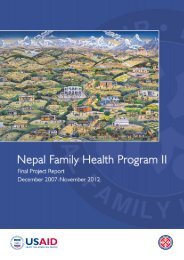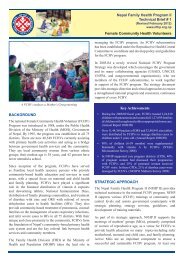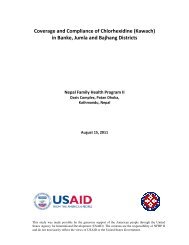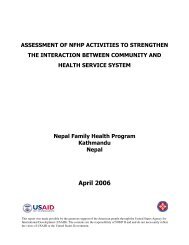A Study on Family Planning Needs of Migrant Couples in Nepal
A Study on Family Planning Needs of Migrant Couples in Nepal
A Study on Family Planning Needs of Migrant Couples in Nepal
You also want an ePaper? Increase the reach of your titles
YUMPU automatically turns print PDFs into web optimized ePapers that Google loves.
∼Terms <strong>of</strong> Reference (ToR) ∼<br />
A <str<strong>on</strong>g>Study</str<strong>on</strong>g> <strong>on</strong> <strong>Family</strong> <strong>Plann<strong>in</strong>g</strong> <strong>Needs</strong> <strong>of</strong> <strong>Migrant</strong> <strong>Couples</strong> <strong>in</strong> <strong>Nepal</strong><br />
<strong>Nepal</strong> <strong>Family</strong> Health Program II (NFHP II) is solicit<strong>in</strong>g proposals from c<strong>on</strong>sult<strong>in</strong>g firms experienced <strong>in</strong><br />
qualitative research methods for the c<strong>on</strong>duct <strong>of</strong> a study <strong>on</strong> <strong>Family</strong> <strong>Plann<strong>in</strong>g</strong> <strong>Needs</strong> <strong>of</strong> <strong>Migrant</strong> <strong>Couples</strong> <strong>in</strong><br />
<strong>Nepal</strong>. The proposal should c<strong>on</strong>ta<strong>in</strong> a brief background, detail methodology for the study <strong>in</strong>clud<strong>in</strong>g selecti<strong>on</strong><br />
<strong>of</strong> study districts and study subjects, sample size, activity schedule, key pers<strong>on</strong>nel with their CVs, an<br />
estimated budget with detailed l<strong>in</strong>e items, and an organizati<strong>on</strong> pr<strong>of</strong>ile. A brief background, objectives <strong>of</strong> the<br />
study and a broad idea <strong>on</strong> methodology are provided <strong>in</strong> this ToR.<br />
1. Background<br />
NFHP II aims to improve the delivery and use <strong>of</strong> public sector services such as family plann<strong>in</strong>g (FP),<br />
maternal, newborn and child health (MNCH) with the aim <strong>of</strong> strengthen<strong>in</strong>g the local capacity to provide<br />
these basic health services. Past Demographic and Health Surveys (1996, 2001 and 2006) show that there has<br />
been almost a 2 percent <strong>in</strong>crease per year <strong>in</strong> C<strong>on</strong>traceptive Prevalence Rate (CPR) <strong>in</strong> <strong>Nepal</strong>. However, the<br />
2009 NFHP II Mid-term Survey revealed that <strong>in</strong> rural areas <strong>of</strong> <strong>Nepal</strong>, there has been a very slow <strong>in</strong>crease <strong>in</strong><br />
CPR s<strong>in</strong>ce 2006, account<strong>in</strong>g <strong>on</strong>ly for a 1 percent <strong>in</strong>crease with<strong>in</strong> a three-year period. This study also<br />
documented spousal separati<strong>on</strong> as <strong>on</strong>e <strong>of</strong> the major c<strong>on</strong>tribut<strong>in</strong>g factor for slow<strong>in</strong>g the past trend <strong>in</strong> use <strong>of</strong><br />
FP.<br />
Foreign migrati<strong>on</strong> has, over the years, become a major feature <strong>of</strong> <strong>Nepal</strong>’s ec<strong>on</strong>omy and society. Work<br />
migrati<strong>on</strong> is highest <strong>in</strong> the rural western hills, engag<strong>in</strong>g 45 percent <strong>of</strong> men. 1 Although <strong>Nepal</strong>i workers<br />
migrate to several countries <strong>in</strong> the Middle East and even Europe, the major dest<strong>in</strong>ati<strong>on</strong> for about 77% <strong>of</strong> the<br />
migrat<strong>in</strong>g populati<strong>on</strong> is India. 2 An estimated 60,000-1.3 milli<strong>on</strong> <strong>Nepal</strong>ese migrate to India al<strong>on</strong>e, for seas<strong>on</strong>al<br />
or l<strong>on</strong>g-term work, engag<strong>in</strong>g <strong>in</strong> manual labor jobs <strong>in</strong> <strong>in</strong>dustry, c<strong>on</strong>structi<strong>on</strong> work, agriculture, or the service<br />
sector. 3 <strong>Nepal</strong> government statistics reports that for the period from 1993 to 2009 nearly 1.4 milli<strong>on</strong> <strong>Nepal</strong>ese<br />
went to countries other than India for employment. 4 It is likely that these figures underestimate the actual<br />
volume. A paper based <strong>on</strong> analysis <strong>of</strong> NDHS 2006 data reports that at the time <strong>of</strong> the survey about 13% <strong>of</strong><br />
the populati<strong>on</strong> (~3.5 milli<strong>on</strong> people) had been away from home for more than 6 m<strong>on</strong>ths 5 . Another recent<br />
survey 6 estimated that 44% <strong>of</strong> households <strong>in</strong> <strong>Nepal</strong> have at least <strong>on</strong>e member currently liv<strong>in</strong>g either abroad<br />
or elsewhere <strong>in</strong> <strong>Nepal</strong>.<br />
The NFHP II mid-term survey 2009 reported that husbands <strong>of</strong> nearly <strong>on</strong>e-third (32%) <strong>of</strong> the rural women<br />
were liv<strong>in</strong>g away from them at the time <strong>of</strong> the survey, and this trend is <strong>in</strong>creas<strong>in</strong>g. With regards to pattern <strong>of</strong><br />
migrati<strong>on</strong>, more than <strong>on</strong>e-half (54%) <strong>of</strong> the husbands were away for less than six m<strong>on</strong>ths, with median<br />
durati<strong>on</strong> <strong>of</strong> away be<strong>in</strong>g five m<strong>on</strong>ths. The most frequent dest<strong>in</strong>ati<strong>on</strong>s for shorter durati<strong>on</strong>s <strong>of</strong> time have been<br />
to <strong>Nepal</strong> and India, while migrants seem to choose other countries for l<strong>on</strong>ger durati<strong>on</strong>s <strong>of</strong> time. The survey<br />
also reported that less than <strong>on</strong>e-quarters (23%) <strong>of</strong> the separated couples used c<strong>on</strong>traceptives whereas it was<br />
nearly three-fifths (62%) am<strong>on</strong>g couples liv<strong>in</strong>g together. Similarly, the use <strong>of</strong> c<strong>on</strong>tracepti<strong>on</strong> decreases as the<br />
durati<strong>on</strong> <strong>of</strong> separati<strong>on</strong> <strong>in</strong>creases. Furthermore, wives <strong>of</strong> migrant husbands were younger, had a smaller<br />
Page 1 <strong>of</strong> 5, May 5, 2011
number <strong>of</strong> children, and had much higher level <strong>of</strong> unmet need than those women who were liv<strong>in</strong>g together<br />
with their husbands at the time <strong>of</strong> the survey.<br />
2. Rati<strong>on</strong>ale<br />
Women whose spouse has been liv<strong>in</strong>g away from them for a c<strong>on</strong>siderable amount <strong>of</strong> time may have different<br />
reproductive health and FP demands as compared to those women whose husbands usually stay with them.<br />
Due to spouse separati<strong>on</strong>, the women might not use FP methods regularly. In additi<strong>on</strong>, there is less likely <strong>of</strong><br />
sexual relati<strong>on</strong>ship outside the marriage uni<strong>on</strong> <strong>in</strong> <strong>Nepal</strong>. As a result, when their husbands return home for a<br />
short period <strong>of</strong> time, they are unprepared and also less likely to use FP methods. C<strong>on</strong>sequently, there is a<br />
high possibility <strong>of</strong> unplanned and unwanted pregnancies. Unwanted pregnancies expose women to additi<strong>on</strong>al<br />
health risks by <strong>in</strong>creas<strong>in</strong>g the number <strong>of</strong> lifetime pregnancies, <strong>in</strong>adequate birth spac<strong>in</strong>g, more deliveries, and<br />
also <strong>in</strong>duced aborti<strong>on</strong>s push<strong>in</strong>g women's life to further risks. Because <strong>of</strong> all these, there is a need <strong>of</strong> an<br />
<strong>in</strong>itiative that will help this subset <strong>of</strong> populati<strong>on</strong> for adopti<strong>on</strong> <strong>of</strong> FP for improved maternal health, decreased<br />
aborti<strong>on</strong> rate, planned pregnancy and preparedness, spac<strong>in</strong>g and child survival.<br />
Past studies c<strong>on</strong>ducted by New ERA and <strong>Family</strong> Health Internati<strong>on</strong>al <strong>on</strong> populati<strong>on</strong> mobility and risk<br />
behavior am<strong>on</strong>g migrant populati<strong>on</strong>s focus primarily <strong>on</strong> the transmissi<strong>on</strong> <strong>of</strong> STDs and HIV/AIDS because<br />
the migrant populati<strong>on</strong> is <strong>of</strong> a sexually active age, thus creat<strong>in</strong>g c<strong>on</strong>diti<strong>on</strong>s that may be c<strong>on</strong>ducive to the<br />
transmissi<strong>on</strong> <strong>of</strong> HIV and STDs when the <strong>in</strong>fected migrant males return home with the virus and <strong>in</strong>fect their<br />
wives. <strong>Family</strong> <strong>Plann<strong>in</strong>g</strong> Associati<strong>on</strong> <strong>of</strong> <strong>Nepal</strong> (FPAN) have reported that labor migrati<strong>on</strong> has made the young<br />
populati<strong>on</strong> at high risk <strong>of</strong> hav<strong>in</strong>g unwanted pregnancies <strong>in</strong> additi<strong>on</strong> to STI/HIV <strong>in</strong>fecti<strong>on</strong>, report<strong>in</strong>g this<br />
vulnerability as partly due to limited access to youth friendly sexual and reproductive health <strong>in</strong>formati<strong>on</strong> and<br />
services. 7 Despite these brief references, no robust studies have been c<strong>on</strong>ducted to study migrati<strong>on</strong> <strong>of</strong> males<br />
and use <strong>of</strong> FP. Therefore, a study to explore the perspectives <strong>of</strong> the migrant couples and other c<strong>on</strong>cerned<br />
people has become necessary to meet the FP need <strong>of</strong> the migrant populati<strong>on</strong> <strong>in</strong> an effective way.<br />
3. Research questi<strong>on</strong>s<br />
The key questi<strong>on</strong>s guid<strong>in</strong>g this study are:<br />
1. What is the pattern <strong>of</strong> sex and use <strong>of</strong> FP methods when the migrant husband comes to visit their<br />
wives?<br />
2. Do the migrant couples discuss <strong>on</strong> FP when they meet each other? How <strong>of</strong>ten do they discuss? Do<br />
they plan and prepare before hav<strong>in</strong>g sex?<br />
3. What is the level <strong>of</strong> knowledge and utilizati<strong>on</strong> <strong>of</strong> reproductive health services while their husband is<br />
away/comes to visit?<br />
4. What is the pattern <strong>of</strong> separati<strong>on</strong> by durati<strong>on</strong> <strong>of</strong> migrati<strong>on</strong> and dest<strong>in</strong>ati<strong>on</strong>?<br />
5. How to improve FP practices am<strong>on</strong>g the migrant couples?<br />
6. What is the chance <strong>of</strong> aborti<strong>on</strong> due to lack <strong>of</strong> FP am<strong>on</strong>g the migrant couples?<br />
7. What are the possible ways to avoid unwanted pregnancies when migrant couples meet each other?<br />
8. How to meet the overall FP need <strong>of</strong> the migrant couples?<br />
9. What barriers stopped women from us<strong>in</strong>g FP methods despite their <strong>in</strong>terest?<br />
Page 2 <strong>of</strong> 5, May 5, 2011
4. Objectives<br />
The ma<strong>in</strong> objective <strong>of</strong> the study is to know the perspectives <strong>of</strong> the migrant couples and other key <strong>in</strong>formants<br />
to meet the overall FP needs <strong>of</strong> the migrant couples.<br />
The specific objectives <strong>in</strong>clude to:<br />
1. Assess the knowledge <strong>of</strong> migrant couples about FP methods and identify perceived FP needs al<strong>on</strong>g<br />
with plann<strong>in</strong>g and preparedness,<br />
2. F<strong>in</strong>d out sexual behavior <strong>of</strong> migrant spouses and use <strong>of</strong> FP when the couples meet each other,<br />
3. Identify the barriers for not us<strong>in</strong>g FP by the migrant couples,<br />
4. Explore the <strong>in</strong>cidence <strong>of</strong> unwanted and unplanned pregnancies, outcomes <strong>of</strong> such pregnancies, and<br />
their knowledge about health c<strong>on</strong>sequences as a result <strong>of</strong> unplanned pregnancies,<br />
5. Identify ways to reach FP <strong>in</strong>formati<strong>on</strong> and services to married migrant populati<strong>on</strong> from the migrants<br />
and key <strong>in</strong>formants perspectives particularly when the couples meet each other.<br />
5. Proposed Methodology<br />
5.1 <str<strong>on</strong>g>Study</str<strong>on</strong>g> Design: This will be a qualitative study. Because <strong>of</strong> this, the design should be such that it targets<br />
the subjects who can reliably <strong>in</strong>form about the research questi<strong>on</strong>s rather than represent an overall populati<strong>on</strong>.<br />
The design should help programmers understand the phenomen<strong>on</strong> <strong>of</strong> FP need <strong>of</strong> migrant couples.<br />
5.2 <str<strong>on</strong>g>Study</str<strong>on</strong>g> Area: A total <strong>of</strong> six districts with high out migrati<strong>on</strong>, both with<strong>in</strong> and outside <strong>Nepal</strong> should be<br />
proposed for the study. As the results <strong>of</strong> the study are anticipated to provide <strong>in</strong>puts <strong>in</strong> develop<strong>in</strong>g a nati<strong>on</strong>al<br />
FP strategy to address the needs <strong>of</strong> migrant populati<strong>on</strong>s, the districts chosen should represent geographical<br />
z<strong>on</strong>es as the dest<strong>in</strong>ati<strong>on</strong> <strong>of</strong> migrati<strong>on</strong> also differs by geographical regi<strong>on</strong>. Therefore, 3 districts from<br />
Hill/Mounta<strong>in</strong> areas and 3 districts from Pla<strong>in</strong> areas should be proposed, with their distributi<strong>on</strong> be<strong>in</strong>g <strong>in</strong><br />
various development regi<strong>on</strong>s with<strong>in</strong> <strong>Nepal</strong>.<br />
5.3 <str<strong>on</strong>g>Study</str<strong>on</strong>g> Subjects: The study subjects are married couples who meet at least <strong>on</strong>e <strong>of</strong> the follow<strong>in</strong>g criteria:<br />
• Wives whose husbands are away from home at present,<br />
• Wives <strong>of</strong> childbear<strong>in</strong>g age whose husbands usually stay outside but are at home at present, and<br />
• Husbands who have wives <strong>of</strong> reproductive age and who are currently at home but usually live away<br />
from home.<br />
5.4 <str<strong>on</strong>g>Study</str<strong>on</strong>g> Methods: In-depth Interviews (IDI), Key Informant Interviews (KII), and Focus Group Discussi<strong>on</strong><br />
(FGD) should be used to collect <strong>in</strong>formati<strong>on</strong>. IDI will be c<strong>on</strong>ducted with the migrant males and their wives.<br />
The wives whose husbands are currently stay<strong>in</strong>g outside their home and the husbands who have recently<br />
returned home from outside temporarily or permanently should be <strong>in</strong>terviewed. Moreover, FGDs will be<br />
c<strong>on</strong>ducted with the above categories <strong>of</strong> resp<strong>on</strong>dents. KIIs will be organized with District Public Health<br />
Offices (DPHO) and supervisors, Female Community Health Volunteers (FCHVs), health workers, school<br />
teachers, Health Facility Operati<strong>on</strong> and Management Committee (HFOMC) members, and local leaders as<br />
appropriate. The c<strong>on</strong>sult<strong>in</strong>g firm should propose the number <strong>of</strong> IDIs, KIIs and FGDs per district with proper<br />
justificati<strong>on</strong>.<br />
5.5 Selecti<strong>on</strong> <strong>of</strong> <str<strong>on</strong>g>Study</str<strong>on</strong>g> Sites: <str<strong>on</strong>g>Study</str<strong>on</strong>g> subjects should be purposively selected with <strong>in</strong>itial screen<strong>in</strong>g procedure<br />
to recruit the different category <strong>of</strong> resp<strong>on</strong>dents. We propose that <strong>in</strong> each district, 2 VDCs with high out<br />
migrati<strong>on</strong> is identified from sec<strong>on</strong>dary data sources and also <strong>in</strong> c<strong>on</strong>sultati<strong>on</strong> with DPHOs/DDC. From each<br />
Page 3 <strong>of</strong> 5, May 5, 2011
<strong>of</strong> the VDCs, wards or communities should be further identified, followed by identify<strong>in</strong>g the resp<strong>on</strong>dents<br />
themselves <strong>in</strong> c<strong>on</strong>sultati<strong>on</strong> with FCHVs and VDC Secretary.<br />
The durati<strong>on</strong> <strong>of</strong> husband-wife separati<strong>on</strong> is <strong>on</strong>e <strong>of</strong> the important dimensi<strong>on</strong>s <strong>of</strong> this study design because it is<br />
likely that the FP needs <strong>of</strong> the migrants vary by their durati<strong>on</strong> <strong>of</strong> separati<strong>on</strong>. More importantly, the risk <strong>of</strong><br />
pregnancy is associated with the meet<strong>in</strong>g frequency between wives and husband regardless <strong>of</strong> the durati<strong>on</strong><br />
away from each other. Because the wives <strong>of</strong> those migrant husbands who are the frequent visitors to their<br />
homes are at higher risk <strong>of</strong> pregnancy. Therefore, the sample should <strong>in</strong>clude resp<strong>on</strong>dents who have spousal<br />
separati<strong>on</strong> for both shorter and l<strong>on</strong>ger durati<strong>on</strong>s <strong>of</strong> time, <strong>in</strong>clud<strong>in</strong>g those who are likely to meet at least <strong>on</strong>ce<br />
or twice a year. Another important characteristic <strong>of</strong> the resp<strong>on</strong>dents to c<strong>on</strong>sider dur<strong>in</strong>g their selecti<strong>on</strong> is<br />
caste/ethnicity.<br />
5.6 Analysis: The f<strong>in</strong>d<strong>in</strong>gs <strong>of</strong> the study should be analyzed accord<strong>in</strong>g to the research questi<strong>on</strong> and objectives<br />
disaggregated by key characteristics <strong>of</strong> the study subjects <strong>in</strong> relati<strong>on</strong> to their caste/ethnicity, age, ecological<br />
z<strong>on</strong>e, durati<strong>on</strong> <strong>of</strong> separati<strong>on</strong>, reas<strong>on</strong> for migrati<strong>on</strong> and place <strong>of</strong> migrati<strong>on</strong>.<br />
6. Scope <strong>of</strong> Work<br />
The c<strong>on</strong>sult<strong>in</strong>g firm should work <strong>in</strong> close coord<strong>in</strong>ati<strong>on</strong> with NFHP II M<strong>on</strong>itor<strong>in</strong>g and Evaluati<strong>on</strong> team to<br />
carry out the study. NFHP II will provide necessary technical support <strong>in</strong> f<strong>in</strong>aliz<strong>in</strong>g methodology and study<br />
<strong>in</strong>struments and <strong>in</strong>formati<strong>on</strong> analysis. Follow<strong>in</strong>g will be the scope <strong>of</strong> work for the c<strong>on</strong>sult<strong>in</strong>g firm.<br />
• Design and develop detail methodology for the study<br />
• Develop and f<strong>in</strong>alize <strong>in</strong>struments and share with NFHP II<br />
• Recruit capable field researchers and tra<strong>in</strong> them<br />
• C<strong>on</strong>duct field work to collect <strong>in</strong>formati<strong>on</strong><br />
• Outl<strong>in</strong>e the format for report and share it with NFHP II<br />
• Analyze the collected <strong>in</strong>formati<strong>on</strong><br />
• Prepare draft report and share it with NFHP II<br />
• F<strong>in</strong>alize report<br />
• Present the f<strong>in</strong>d<strong>in</strong>gs <strong>of</strong> the study <strong>in</strong> appropriate forums organized by NFHP II<br />
The c<strong>on</strong>sult<strong>in</strong>g firm cannot subc<strong>on</strong>tract whole or any part <strong>of</strong> the above activities without the prior approval<br />
<strong>of</strong> NFHP II.<br />
The c<strong>on</strong>sult<strong>in</strong>g firm <strong>in</strong>clud<strong>in</strong>g the proposed human resources should have dem<strong>on</strong>strated background and<br />
experience <strong>in</strong> c<strong>on</strong>duct<strong>in</strong>g qualitative research.<br />
7. Deliverables<br />
The selected c<strong>on</strong>sult<strong>in</strong>g firm is liable to deliver the follow<strong>in</strong>gs to NFHP II:<br />
• Research <strong>in</strong>struments both <strong>in</strong> English and <strong>Nepal</strong>i.<br />
• Draft report for review and comments.<br />
• Five hard copies <strong>of</strong> the f<strong>in</strong>al report and an electr<strong>on</strong>ic copy both <strong>in</strong> word format and pdf format.<br />
• Electr<strong>on</strong>ic copy <strong>of</strong> raw data and dummies.<br />
Page 4 <strong>of</strong> 5, May 5, 2011
8. <str<strong>on</strong>g>Study</str<strong>on</strong>g> Durati<strong>on</strong><br />
The c<strong>on</strong>sult<strong>in</strong>g firm should develop a detailed study implementati<strong>on</strong> plan and share it with NFHP II. The<br />
entire durati<strong>on</strong> <strong>of</strong> the study should not exceed four m<strong>on</strong>ths from the date <strong>of</strong> sign<strong>in</strong>g the c<strong>on</strong>tract.<br />
9. Cost Estimati<strong>on</strong><br />
The c<strong>on</strong>sult<strong>in</strong>g firm should submit a realistic and competitive survey cost estimates for cost comparis<strong>on</strong>s and<br />
eventual c<strong>on</strong>tract negotiati<strong>on</strong>s. The cost estimates should be <strong>in</strong> major head<strong>in</strong>gs with detailed breakdown by<br />
activities under each head<strong>in</strong>g.<br />
10. Submissi<strong>on</strong> <strong>of</strong> Proposal<br />
C<strong>on</strong>sult<strong>in</strong>g firm is required to submit two hard copies <strong>of</strong> the proposal to NFHP II. Please also <strong>in</strong>clude a copy<br />
<strong>of</strong> tax registrati<strong>on</strong> and clearance certificate al<strong>on</strong>g with the proposal. The envelop <strong>of</strong> the proposal should be<br />
marked 'A study <strong>on</strong> FP need <strong>of</strong> migrant couples <strong>in</strong> <strong>Nepal</strong>' and reach the follow<strong>in</strong>g address by close <strong>of</strong><br />
bus<strong>in</strong>ess May 23, 2011. NFHP II reserves rights to accept or not to accept the proposal. Teleph<strong>on</strong>e enquiries<br />
will not be enterta<strong>in</strong>ed.<br />
Team Leader/Sub Agreement and Procurement<br />
<strong>Nepal</strong> <strong>Family</strong> Health Program II<br />
Oasis Complex, Third Floor<br />
Patan Dhoka, Lalitpur<br />
References<br />
1<br />
2<br />
3<br />
4<br />
5<br />
6<br />
7<br />
Resilience Amidst C<strong>on</strong>flict- An Assessment <strong>of</strong> Poverty <strong>in</strong> <strong>Nepal</strong> 1995-96 and 2003-2004-Chapter 4- The Impact <strong>of</strong><br />
Migrati<strong>on</strong> and Remittance.<br />
Address<strong>in</strong>g the <strong>Needs</strong> <strong>of</strong> <strong>Nepal</strong>i <strong>Migrant</strong> Workers <strong>in</strong> <strong>Nepal</strong> and <strong>in</strong> Delhi, India, Mounta<strong>in</strong> Research Development<br />
2005.<br />
UNGASS Nati<strong>on</strong>al Report- <strong>Nepal</strong>, 2005.<br />
M<strong>in</strong>istry <strong>of</strong> Labor and Transport Management (MOLTM), Data Sheet. www.d<strong>of</strong>e.gov.np. Department <strong>of</strong><br />
Foreign Employment, Government <strong>of</strong> <strong>Nepal</strong>, Kathmandu, <strong>Nepal</strong>: MOLTM, 2009.<br />
Thapa S, Decl<strong>in</strong><strong>in</strong>g Trends <strong>of</strong> Infant, Child and Under-5 Mortality <strong>in</strong> <strong>Nepal</strong>, Journal <strong>of</strong> Tropical Pediatrics, 2008,<br />
54(4): 265-8.<br />
Central Bureau <strong>of</strong> Statistics (CBS), Report <strong>on</strong> the <strong>Nepal</strong> Labor Force Survey 2008. Nati<strong>on</strong>al <strong>Plann<strong>in</strong>g</strong> Commissi<strong>on</strong><br />
Secretariat, Government <strong>of</strong> <strong>Nepal</strong>, United Nati<strong>on</strong>s Development Programme, and Internati<strong>on</strong>al Labor<br />
Organizati<strong>on</strong>, Kathmandu, <strong>Nepal</strong>: CBS, 2009.<br />
FPAN, Annual Work Program Budget 2010- Overall Program Summary.<br />
Page 5 <strong>of</strong> 5, May 5, 2011



